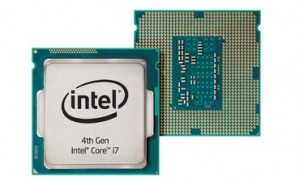
Intel introduced its 4th generation Intel Core Processor family at Computex Taipei 2013 on Tuesday. This launch will bring in a wave of new Ultrabook and emerging 2-in-1 devices that seek to blur the lines between PCs and tablets.
Speaking at Computex Taipei 2013, executive vice president Tom Kilroy said “Intel has more than 50 different 2-in-1 designs in the pipeline across a range of price points, including premium Ultrabook 2-in-1 devices powered by the new Intel Core processors, and other designs powered by forthcoming processors based on the company’s 22nm Silvermont microarchitecture. ”
“Today we deliver on the vision set forth two years ago to reinvent the laptop with the introduction of our 4th generation Intel Core processors that were designed from the ground up for the Ultrabook and serve as the foundation for a new era of 2-in-1 computing,” said Kilroy. “We made one of the most seismic changes to our roadmap ever to build these new Core processors that deliver the stunning performance of the PC and the mobility of a tablet in one device. The new processors power the most exciting 2-in-1 designs to-date,” he added.
Kilroy also highlighted momentum in ultra-mobility, pointing to Intel’s next-generation 22nm quad-core and most powerful Intel Atom system-on-chip (SoC; codenamed Bay Trail-T) yet for tablets coming this holiday, the company’s forthcoming 4G LTE multimode solution and its next-generation 22nm Atom SoC (codenamed Merrifield) for smartphones.
“With the new Intel Core processors introduced today, our next-generation Atom SoC for tablets and other 22nm products coming soon, the advances in Intel architecture are accelerating the pace of innovation, enabling new experiences and powering some of the best mobile devices coming to market this year,” said Kilroy.
Designed first and foremost with the Ultrabook in mind and based on the company’s flagship 22nmHaswellmicroarchitecture, the 4th generation Intel Core processors deliver a 50% increase in battery life in active workloads over the previous generation. This is the largest generation-over-generation gain in the company’s history, equating to over 9 hours of battery life in active workloads for some Ultrabooks based on the new processors.
Intel’s newest Core processors are the first SoCs for PCs with stunning performance, and power a variety of innovative devices, including Ultrabook, 2-in-1 and portable all-in-one designs. Systems based on the quad-core version of the new Core processors are available now, with additional versions available in the coming months.
The 4th generation Intel Core processors also have built-in graphics that deliver discrete-level performance, or up to two times the performance of Intel’s prior generation. Offered on select versions of the new Intel Core processors, Intel Iris graphics bring the Ultrabook and other mobile PCs to life with built-in, eye-popping visual experiences.
Select Ultrabooks powered by 4th generation Intel Core processors will deliver the Intel performance combined with the mobility and responsiveness of a tablet, making them the premium, ultra-versatile 2-in-1 devices. With touch capability and a keyboard, the system adapts to the user and also offers full application compatibility. People can utilise the system for work and leisure or entertainment purposes.
Kilroy also showcased progress in bringing human-like senses to 2-in-1 and other Intel-based devices through the addition of touch, voice and facial recognition and other technologies. Called perceptual computing, these technologies take advantage of Intel processing power to make interaction with devices natural, intuitive and immersive.
He demonstrated immersive, short-range gesture and voice-based interaction by giving new Intel Core-based Ultrabook 2-in-1 devices ‘eyes’ with the Creative Senz3D peripheral camera, noting general availability for the camera starting next quarter. Looking to the future, he said Intel is working on an integrated solution to build 3-D depth camera technology directly into future Intel-based devices targeted for the second half of 2014.
Intel’s 22nm low-power, high-performance Silvermontmicroarchitecture is enabling the company to accelerate and significantly enhance its tablet and smartphone offerings.
Destined for tablets that will hit the market soon, Intel’s next-generation, 22nm quad-core Atom SoC (Bay Trail-T) will deliver superior graphics and more than two times the CPU performance of the current generation. It will also enable sleek designs with 8 or more hours of battery life and weeks of standby, as well as support Android and Windows 8.1.
Kilroy also demonstrated Intel’s 4G LTE multimode solution in conjunction with the next-generation 22nm quad-core Atom SoC for tablets for the first time. The Intel XMM 7160 is one of the world’s smallest4 and lowest-power multimode-multiband LTE solutions and will support global LTE roaming in a single SKU.
With a number of phones with Intel silicon inside having shipped across more than 30 countries, Kilroy previewed what’s coming. He showed for the first time a smartphone reference design platform based on Merrifield, Intel’s next-generation 22nm Atom SoC for smartphones that will deliver increased performance and battery life. The platform includes an integrated sensor hub for personalized services, as well as capabilities for data, device and privacy protection.






